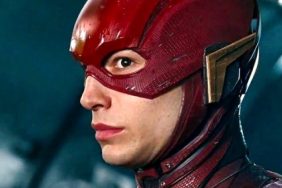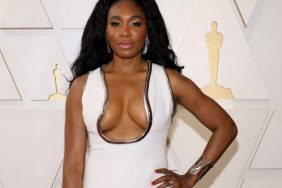There aren’t many recent television series more acclaimed than Hannibal, the bold and psychologically intense adaptation of Thomas Harris’s novels about psychologist/cannibal Hannibal Lecter. Throughout three seasons the series, created by Bryan Fuller (Pushing Daisies), submerged audiences in an extravagant style that mirrored the erudite Lecter’s own personal tastes: swanky suits, elegant music, lush cinematography and meals that were… how best to put this… to die for.
Bryan Fuller is Crave’s new guest editor, and before we get into the meat of his own style and career, we now offer you his take on some of the most beautiful and stylish horror movies ever produced. Fans of Hannibal take note, these ten classic films offer a striking and horrific perspective on cinematic terror. Watching them might just ease your pain after the recent cancellation of Bryan Fuller’s beloved series.
Take it away, Bryan Fuller…
Frankenstein (1931) and Bride of Frankenstein (1935)

Universal Pictures
“All of those early Universal horrors – Frankenstein, Bride of Frankenstein, the ones that are in the ‘30s in particular – are so heavily influenced by German Expressionism and Weimar Cinema. The German influence is so stark and fantastic, yet also reflective of what was going on artistically in Germany at that time, particularly in cinema with [Ernst] Lubitsch and [F.W.] Murnau. Murnau used a lot of moving camera and Lubitsch was so clever with his framing, and James Whale adopted all of those visual stylizations into this uniquely American – yet overwhelmingly influenced by what was going on in European cinema – [style], to create this fantastic hybrid of early American film.

Universal Pictures
“I love how graphic those films are, and how even though they are monster stories, at their core all of the Universal horror tales are really about creatures struggling with loneliness and their place in the world. There’s no greater to Universal horror than being alone. I thought was something that in the revisitations of Universal horror, that we’ve seen a lot of people kind of embrace the ‘back from the dead’ mythology, and miss the much more human components of those stories. That’s what I think their calling card [was] from that era: high stylization, high emotional content, and villains whose biggest crimes are being alone and misunderstood.”
Forbidden Planet (1956)

Metro-Goldwyn-Mayer
“Forbidden Planet is a fantastic film. I love that you qualify it as a horror story because like Alien, which is really ‘Son of Forbidden Planet,’ it is a beautiful hybridization of horror and science fiction. With science fiction you have so many more opportunities for production design to tell a story, and once again, with this tale on this isolated planet, it is about loneliness and isolation and what is our role in the world, and a father who is trying to protect his daughter from the evils of mankind, specifically the evils of himself that he has unleashed.

Metro-Goldwyn-Mayer
“The really rich golden tones of that design, juxtaposed with the brutal horror of this electric monster from the id, give it a flair that transcends both horror and science fiction and creates a new genre. There’s so many of those films of that era that really were working in a hybridization of science fiction and horror, whether it was Invasion of the Body Snatchers or Them. All of our Cold War paranoia gave birth to a fantastic subgenre.”
Psycho (1960)

Universal Pictures
“Psycho is a fascinating film to look at and compare, actually, to early Universal horror, as a modern Universal horror tale of its day. Taking the tropes of Frankenstein and Frankenstein’s maker, and really reconfiguring them so that the maker is Norma Bates and the monster is Norman Bates; Norman suffers in many of the same ways that Frankenstein’s monster did, with isolation and being disconnected, and what happens when he does make a human connection, and how it unleashes the worst of humanity that was brought upon him by his maker, in this case his mother.

Universal Pictures
“So it’s not surprising to see a lot of the graphic influences of Universal horror on Psycho. And of course the constraint that [Alfred] Hitchcock used in making that film as a product of having no studio support, and having to finance it himself, and having to shoot it on a television budget with a television production restraint. [It] actually allowed him to harken back to Hitchcock’s own influences of that era. You can see in his early films, like The Lodger, how heavily influenced he was by German Expressionism. So I guess what we’re looking at is, boy those Germans knew how to scare people! [Laughs.]”
The Haunting (1963)

Metro-Goldwyn-Mayer
“What’s so brilliant about Robert Wise’s The Haunting – in addition to the fantastic production design that gives you that Victorian era terror, that Hammer explored so thoroughly in all of those films – you now get as active a sound design as you do a cinematic production design. What was so brilliant about the frights in The Haunting was that they were primarily aural, and not visual. That’s what so striking to me about The Haunting as a film, that it lives in a soundscape so much more than most films in that genre.

Metro-Goldwyn-Mayer
“The iconography of the house, and that era of the opulent trappings of the wealthy disenfranchised, creates its own brand of horror and its own brand of isolation. Once again, looking at how isolation for the protagonist in The Haunting was her Achilles Heel. She was a woman who found herself simple, in a simple world, then thrust into something that was so overly designed and dripping with detail that it reflected the madness of her mind. So her coming from a relatively simple aesthetic into something was opulent was a marriage of what was happening to her inside her head, now brought to the forefront by something that she couldn’t run from. The banality of the life she lived before she came to the mansion was diametrically opposed to the horror she encountered there.”
The Birds (1963)

Universal Pictures
“The Birds is such a fascinating film, not only in its production design but its color palette. There’s so much about this film that is actually very bright and cheery, and you’ll forgive, the ornithological chipperness of the colors. The beautiful teal… it’s not teal, it’s like a mint green coat… juxtaposed against the robin’s egg blue of the sky, and the stark white of the seagulls that attack Tippi Hedren in her little boat ride through the bay, really hints at what Hitchcock is going for. That everything may seem bright and chipper and cheery and oh, listen to the birds sing, and those birds are going to fucking kill you.

Universal Pictures
“That was the fun of his approach to production design on The Birds, that he was actually using a very bright colorful palette to tell a horror story of the world around us turning against us, in such an unexpected way that something that would normally give us a click in our heel – hearing bird song in the morning – is now turned into something terrifying. And yet we are still in a lovely rural home with a beautiful family, and still the horror of nature is able to find us, in Americana, in bright daylight. That’s something that was very subversive for a horror movie and also had tremendous wit.”
Repulsion (1965)

Compton Films / Royal Films International
“Repulsion… boy, that film… Where to begin with Repulsion? [Roman] Polanski clearly had some influence by surrealist filmmakers like [Luis] Buñuel, where you go to the far reaches of madness that the protagonist is experiencing in that film, and the oppression of apartment living, and the symbolism of being in society, amongst society, isolated by society and trapped by your own mind were all so cleverly represented in the simplicity of that apartment that turned against poor Catherine Deneuve.

Compton Films / Royal Films International
“So once again it was something in the banality of everyday life that became subversive and aggressive, and transgressive, for Polanski as he depicted madness.”
The Rocky Horror Picture Show (1975)

20th Century Fox
“The Rocky Horror Picture Show is a lot of fun to consider as horror production design, in juxtaposition to the other films that we’re discussing, because it’s a comedy and it’s a musical. Yet it relies on certain tropes of the horror story: Brad and Janet finding a haunted mansion in the middle of a rainy night, and then going inside that haunted mansion and finding something so pop, and Warholian. It’s production design that you would think would subvert the horror, but actually provided an accelerant for the strange, and made the surroundings not necessarily ‘horrific’ but perverted to the point of being seductive and repulsive simultaneously.

20th Century Fox
“As far as that far film has reached its midnight audiences and invited that audience to participate in the performances, it seems like it broke the fourth wall beyond every time that Tim Curry made eye contact with the camera. Even that style, which is very winky and in the know, it invited the audiences in from the very first frame. That’s one thing that The Rocky Horror Picture Show has brought to the horror genre, more than any other film, that it wrapped those big lips around the audience and sucked them in.”
Creepshow (1982)

Warner Bros.
“I love Creepshow. It’s one of my favorite films. I think it’s a perfect film that [did] exactly what it intended; it brought the spirit of EC Comics to the sense and sensibility of Stephen King. The production design and the style of the filmmaking is also heavily influenced by those Vault of Terror tales. The first thing you realize with the music, the tone that music strikes is very ‘80s, very synth, but it’s also telling the audience we are going to have fun with this story and the filmmaking doesn’t let the audience down on that. You have the vivid four-color panels of the different tales.

Warner Bros.
“The very adult humor of the relationships within the picture, particularly in “The Crate” where you have Adrienne Barbeau and Hal [Holbrook]. The kinkiness of the relationship between [Hal Holbrook] and Adrienne Barbeau, and the wish fulfillment of being able to use one monster to eliminate another, was also part and parcel of what the EC Comics brand represented. Which was these were all morality tales and everyone in them has it coming in some way or another. So that allows the audience to be terrified but also, in that very Catholic way, enjoy the comeuppance of the ne’er-do-wells.”
Under the Skin (2013)

A24 Films
“Let’s talk about Under the Skin, as something that’s a relatively recent one. That movie was my favorite of the year it was released, and I love – once again – the very wild disparity between how the banality of Scotland cruising was juxtaposed with an alien’s eye to this world. You see how rough the filmmaking, and simple the filmmaking was, in the scenes where Scarlett Johansson is looking for potential suitors, juxtaposed with the high grand style – surreal style – of the interior of her alien world.

A24 Films
“Stark white floors or stark black floors that are reflecting everything around them. It really was two worlds delivered synonymously in one picture, by a brilliant director.”
Top Photo: Universal Pictures
Also: A Brief History Of Weird Sci-Fi Fashion
Nine Weird Sci-Fi Fashion Movies
-
The Hunger Games (2012)

For a film that is ostensibly about youths murdering each other for the enjoyment of the upper crust, The Hunger Games spends a curious amount of time on constructing haute couture. It's okay to be a badass, just make sure you can also rock a strapless chiffon.
Photo: Lionsgate
-
Bill & Ted's Bogus Journey (1991)

In the future, when all is ruled by peace and good rock music, shaped by surfer dudes from San Dimas, CA, we'll all be wearing neon foam rubber.
Photo: Orion
-
Star Trek: Insurrection (1998)

If you're an immortal and youthful peacenik, you'll wear the drabbest possible clothing.
Photo: Paramount
-
Battlefield Earth (2000)

Tyrannical aliens from the planet Psychlo not only look weird, they dress weird. What is up with their hair? And isn't there a more discreet way to inhale your native planet's air than those snot-looking tubes?
Photo: Warner Bros.
-
The Road Warrior (1981)

Tyrannical cult leaders in a post-apocalyptic wasteland must dress in fetish gear. Which, I guess was the only clothing that survived the apocalypse. Wouldn't the desert warrant more coverage?
Photo: Warner Bros.
-
The Island of Dr. Moreau (1996)

“I can turn animals into men. What's a good way to inspire their loyalty? I know! I'll dress like a gay circus tent!”
Photo: New Line Cinema
-
Zardoz (1974)

I can't speak to anything in this bonkers-ass movie. The fashions are actually the least of its troubles. But they are part of its troubles.
Photo: 20th Century Fox
-
The Fifth Element (1997)

I'm not sure that our ultra-popular media personalities will ever look like the slinky, leaopard-and-rose-wearing Ruby Rhod in the wonderfully out-there Luc Besson sci-fi freakout.
Photo: Columbia Pictures
-
The Star Wars Holiday Special (1978)

Between the bizarro, multi-armed woman, the rock bands of the future, the Cirque du Soliel performance, and the usual Han Solo disco pants, we're looking at the work of a drunken tailor.
Photo: 20th Century Fox








